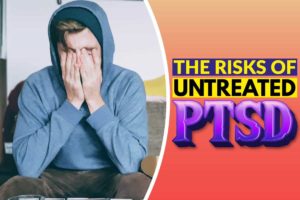
Post-traumatic stress disorder or PTSD is a somewhat common mental health disorder, and it’s also considered very treatable. Unfortunately, many people don’t get treatment for any number of reasons, increasing their risk of serious complications.
Below is more information about PTSD and the risks of leaving it untreated.
An Overview Of PTSD
PTSD is a mental health disorder you can develop after experiencing something traumatic. The traumatic event can include being involved in a severe car accident, a natural disaster, combat, or a sexual assault. Some situations aren’t necessarily dangerous but are sudden and upsetting, which can lead to PTSD. An illness or the death of a loved one are examples.
We all feel a sense of fear when going through something traumatic, which triggers our body’s natural fight-or-flight response. That’s how your body protects itself from danger. Your fight-or-flight response leads to the release of specific hormones. There’s also an increase in breathing, heart rate and blood pressure.
That’s all normal during a stressful or scary time, but if you develop PTSD, those symptoms don’t necessarily subside when the danger passes. Someone with post-traumatic stress disorder might feel anxiety and fear long after the event.
Not everyone experiencing a traumatic event will develop PTSD. Risk factors, personal and protective factors, your brain, and genetics all play a role.
Risk factors include being a woman, having a history of childhood trauma, and having little or no social support after the event occurs.
The symptoms of PTSD can be grouped into four categories. These are:
- Re-experiencing symptoms where you have reminders that once again make you feel a sense of fear or terror. Flashbacks, scary thoughts, and nightmares are specific examples of these types of symptoms.
- Avoidance symptoms mean you might avoid people, places, or things that remind you of the experience. You might even try to avoid feelings or thoughts that bring it up for you.
- Arousal and reactivity symptoms cause you to feel edgy and constantly on high alert. Examples include feeling jumpy or tense, having sleep problems, being startled easily, and having angry outbursts.
- Cognition and mood symptoms relate to your beliefs and feelings. You might have symptoms like blame or guilt, loss of interest, or problems concentrating.
Treatment
As with any other health condition, there are diagnostic criteria that can be used to determine whether you have PTSD.
The Diagnostic and Statistical Manual of Mental Disorders (DSM-5), published by the American Psychiatric Association, has the diagnostic information used by health care professionals.
If you’re diagnosed with PTSD, treatment can help you get a sense of control over your life and your symptoms.
Primarily, the treatment for PTSD is talk therapy, also known as psychotherapy. During psychotherapy for PTSD, you’ll learn skills to manage your symptoms. You can learn how to think differently about yourself, other people, and the world and cope if you experience symptoms or triggers. You can also receive treatment for other problems that relate to the trauma you experienced, such as anxiety or the misuse of alcohol.
Cognitive therapy is one of the most commonly used types of talk therapy for PTSD. Cognitive therapy focuses on recognizing the thought patterns that are keeping you stuck. For PTSD, exposure therapy might be an option too. Exposure therapy is a form of behavioral therapy that helps you face the memories and situations that are traumatic for you.
The goal of any kind of therapy for PTSD is to help you learn how to handle stress in your life and regain control over your lasting fear.
Medications might be combined with therapy.
Antidepressants are among the most frequently relied-on medicines for depression and anxiety. These include selective serotonin reuptake inhibitors (SSRIs).
Lifestyle changes that are helpful for PTSD include staying connecting to people who are caring and supportive, getting plenty of exercise, and eating and sleeping well. Support groups are also a great option.
What Happens If You Don’t Get Treatment?
Unfortunately while there are many fantastic treatment options available for PTSD, a lot of people don’t use them for one reason or another.
The PTSD might be undiagnosed, for example, or maybe you’re nervous about the idea of getting help. You might also think you can get through it on your own.
The reality is, not receiving treatment for PTSD is not only going to diminish your quality of life, but it can lead to complications and serious risks.
PTSD is often a progressive disorder, meaning without treatment it tends to get worse rather than better.
People with untreated post-traumatic stress disorder are likely to find over time, it increasingly affects their daily functionality. It can ultimately be debilitating.
Risks of PTSD that isn’t properly treated and managed, specifically, can include:
- Often people with PTSD that isn’t treated start to self-medicate with substances like drugs or alcohol. This makes symptoms worse and can lead to co-occurring disorders such as anxiety, depression or addiction.
- It’s possible to develop problems with anger or have outbursts of rage when you don’t get treatment because of ongoing stress and anxiety. This is especially common in men who haven’t received treatment for PTSD.
- Not receiving treatment for any psychiatric disorder can put a strain on your relationships. This will only increase loneliness and isolation.
- Severe depression is a significant risk with PTSD, and people with severe depression may experience suicidal thoughts or behaviors.
- The more your functionality is impacted, the worse your psychological symptoms are going to be. For example, you may have financial or career problems that then affect your mental health in other ways and make your life more difficult.
The longer you go without treatment for a post-traumatic stress disorder, often the more difficult it is to treat, which is often the case for chronic conditions.
When you’re proactive about getting treatment and you receive the help you need, you can avoid the dangerous psychological and physical side effects that can occur.





















Add Comment